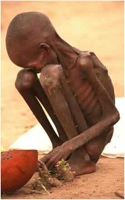Difference between revisions of "Famine"
m (Text replacement - "http://nordan.daynal.org" to "https://nordan.daynal.org") |
m (Text replacement - "http://" to "https://") |
||
| Line 3: | Line 3: | ||
==Etymology== | ==Etymology== | ||
[https://nordan.daynal.org/wiki/index.php?title=English#ca._1100-1500_.09THE_MIDDLE_ENGLISH_PERIOD Middle English], from Anglo-French, from feim, faim hunger, from [[Latin]] fames | [https://nordan.daynal.org/wiki/index.php?title=English#ca._1100-1500_.09THE_MIDDLE_ENGLISH_PERIOD Middle English], from Anglo-French, from feim, faim hunger, from [[Latin]] fames | ||
| − | *Date: [ | + | *Date: [https://www.wikipedia.org/wiki/14th_Century 14th century] |
==Definitions== | ==Definitions== | ||
*1 : an extreme [[scarcity]] of food | *1 : an extreme [[scarcity]] of food | ||
| Line 10: | Line 10: | ||
*4 : a great shortage | *4 : a great shortage | ||
==Description== | ==Description== | ||
| − | A '''famine''' is a widespread scarcity of food that may apply to any [ | + | A '''famine''' is a widespread scarcity of food that may apply to any [https://en.wikipedia.org/wiki/Fauna faunal] species. This [[phenomenon]] is usually accompanied by regional malnutrition, starvation, epidemic, and increased [[Death|mortality]]. |
| − | Emergency measures in relieving famine primarily include providing deficient micronutrients, such as vitamins and minerals, through fortified sachet powders or directly through supplements. The [ | + | Emergency measures in relieving famine primarily include providing deficient micronutrients, such as vitamins and minerals, through fortified sachet powders or directly through supplements. The [https://en.wikipedia.org/wiki/Famine_relief famine relief] [[model]] increasingly used by aid groups calls for giving [[Money|cash]] or cash vouchers to the hungry to pay local farmers instead of buying food from donor countries, often required by [[law]], as it wastes money on transport costs. |
| − | Long term measures include investing in modern [[agriculture]] in places that lack them, such as fertilizers and irrigation, which largely eradicated [ | + | Long term measures include investing in modern [[agriculture]] in places that lack them, such as fertilizers and irrigation, which largely eradicated [https://en.wikipedia.org/wiki/Hunger hunger] in the developed world. However, [https://en.wikipedia.org/wiki/World_Bank World Bank] strictures restrict [[government]] subsidies for farmers and the spread of fertilizer use is hampered by some environmental groups.[https://en.wikipedia.org/wiki/Famine] |
[[Category: Health]] | [[Category: Health]] | ||
Latest revision as of 00:06, 13 December 2020
Etymology
Middle English, from Anglo-French, from feim, faim hunger, from Latin fames
- Date: 14th century
Definitions
- 1 : an extreme scarcity of food
- 2 archaic : starvation
- 3 archaic : a ravenous appetite
- 4 : a great shortage
Description
A famine is a widespread scarcity of food that may apply to any faunal species. This phenomenon is usually accompanied by regional malnutrition, starvation, epidemic, and increased mortality.
Emergency measures in relieving famine primarily include providing deficient micronutrients, such as vitamins and minerals, through fortified sachet powders or directly through supplements. The famine relief model increasingly used by aid groups calls for giving cash or cash vouchers to the hungry to pay local farmers instead of buying food from donor countries, often required by law, as it wastes money on transport costs.
Long term measures include investing in modern agriculture in places that lack them, such as fertilizers and irrigation, which largely eradicated hunger in the developed world. However, World Bank strictures restrict government subsidies for farmers and the spread of fertilizer use is hampered by some environmental groups.[1]
